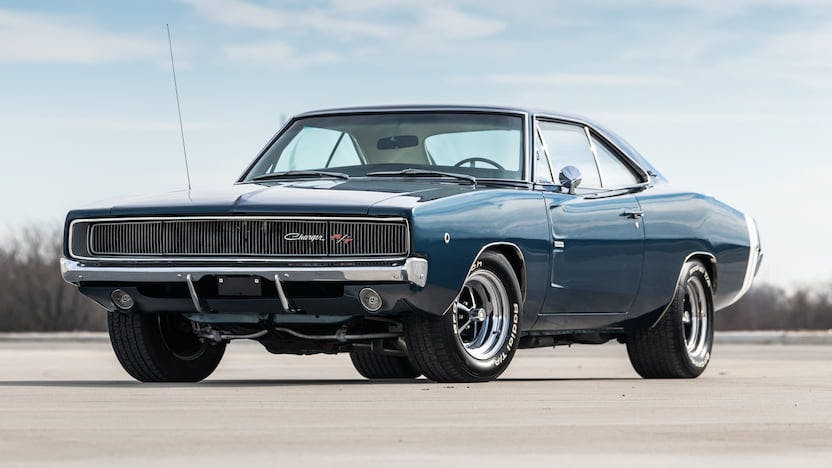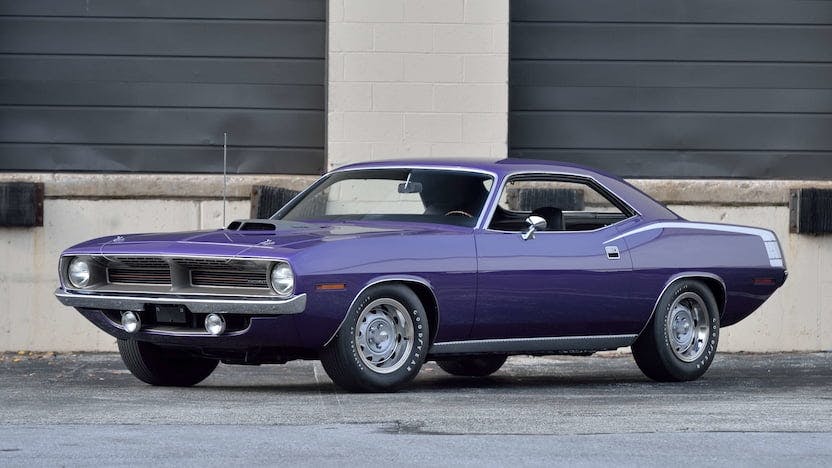6 Hemi-powered muscle cars flying the Mopar flag at Indy 2020
June 6 marks the 95th anniversary of Chrysler, and what better way to celebrate the company than by highlighting what is perhaps its greatest contribution to the automotive pantheon, the Hemi V-8. There have been three generations of Hemi V-8, but none make quite the statement the second-gen does. Whether it was a billboard graphic plastered boldly on the side of a ‘Cuda or the subtle rumble shaking the pavement, if people knew you were packing 426 cubic inches of free-breathing Hemi V-8, they’d give you a wide berth on the street. Conversely, open the hood of your Hemi-powered Dodge or Plymouth muscle car at any car show and you’ll be sure motorheads will come flocking.
We scoured the Mecum’s upcoming 33rd Original Spring Classic in Indianapolis, scheduled for July 10–18, and spotted the following 426-powered beasts, each of them packing a four-speed. Following Indiana’s “Back on Track” plan, both bidders and spectators will be able to see nearly 2,500 cars at the auction, in person if they so choose. Of course, bidding is still available online as well. These six are our favorites, but let us know what your favorite Hemi-powered machine might be, muscle car, or otherwise.
1971 Plymouth Road Runner

Lot K85
With their squared-off wheel openings and low roofline, ’71 Road Runners already had a head start on looking mean. This NASCAR veteran takes that vibe to a new level and brings with it some exclusive Richard Petty provenance. Raced by The King himself, this very car took the checkered flag at Daytona and visited the White House, the only Petty car that can make that claim. Under the hood is a rebuilt 426 Hemi with a custom Petty-Enterprises-fabricated crossram that looks as good as the rest of the car, which has been restored to its 1971 glory. With no functional headlights or taillights its street driving days are over, although it looks like it’s got plenty of super speedway miles left in it.
1968 Dodge Charger R/T

Lot R11
If you’re not a stickler for 100-percent original muscle cars, this may be the Charger for you. Its blue and white color combo is striking, and the original bodywork and trim look great. Look a little deeper, however, and you’ll discover that its Hemi, while mostly stock-appearing, has received some “day-two” upgrades. The V-8, which now breathes through headers and dual three-inch exhaust, has a claimed 601 horsepower and was rebuilt just 1300 miles ago.
1969 Dodge Charger 500

Lot R262
The Charger Daytona and Plymouth Superbird, Mopar’s twin “winged warriors,” got the job done on NASCAR’s biggest, fastest tracks. There’s no denying that. Let’s face it though, their looks are a bit unconventional. The Daytona’s predecessor, the Charger 500, is a much more attractive take on making a production car suitable for 200-mph racing. Rather than the standard Charger’s tunneled back glass, the 500 features a rear window that follows the profile of the C-pillar, just like the Daytona and Superbird. It also ditched the inset headlights and grille from the standard Charger for a flush grille that didn’t act like a parachute at high speeds. Dodge only built 392 of these NASCAR homologation specials for 1968, which is still low production, and this one’s well-optioned with the Super Track Pack 4.10 rear end and power steering and brakes.
1968 Dodge Dart Super Stock

Lot R421
Along with its sister A-body, the Plymouth Barracuda, a select few 1968 Dodge Darts were converted into Super Stock drag racers by Hurst. The cars were stripped down and lightened using almost any means necessary. Lightweight Dodge A100 van bucket seats replaced the factory Dart pieces, and the rear seat was tossed entirely. This example was raced by Terry Pringle as part of the Gene Snow Racing team and has been restored to its as-raced condition complete with cross-ram intake topped with dual Holley carbs. For fans of factory-backed drag racing, few Mopars can come close to the appeal of one of these rare racers.
1970 Plymouth ‘Cuda

Lot R437
’69 Camaros should be Hugger Orange, Mustang Boss 302s belong in school bus yellow, and ‘70s ‘Cudas are the perfect canvas for In-Violet—also known in Dodge nomenclature as Plum Crazy. Or at least, so goes the conventional wisdom. It’s not that other Hight Impact colors aren’t as good, it’s just that this one is so iconic. Only 696 Hemi ‘Cuda hardtops were built in 1970, and only 284 came with a four-speed. It just so happens that this one is also equipped with the Hurst pistol grip shifter, Track Pack rear axle, Rallye Dash, and Rallye wheels. Color can have a bit influence on Mopar muscle car values, and this one may have just the right combo to drive up the bidding.
1965 Plymouth Belvedere

Lot R106
There may have been earlier examples of altered-wheelbase drag cars, but this factory-backed A/FX Belvedere driven by Lee Smith is still a seminal effort in the evolution of the funny car, and it stands as an important piece of Mopar drag racing history.
This dragstrip terror tips the scales at 2800 pounds thanks to an acid-dipped body shell, fiberglass dash, fenders, bumpers, and doors, polycarbonate windows, and a strict diet of race-bred parts. Those include aluminum heads and a magnesium intake for the fuel-injected 426 Hemi. Helping plant what little weight remained on the rear slicks, the front wheels were moved forward 10 inches, and the rear axle was moved forward 15 inches. That dramatic shift in weight balance helped the Belvedere hook up, but it ran afoul of the NHRA class rules for A/FX cars as the wheelbase was tweaked too much for their liking. Only six of these lightweight, factory-sanctioned A/FX cars were built in 1965. While this car has been bid to more than $400,000 in the past, it has failed to meet its reserve in its last two auctions.

